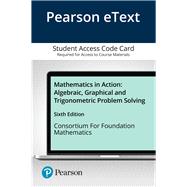Active learning for active minds.
The authors of the Mathematics in Action series believe that students learn mathematics best by actually doing the math within a realistic context. If a student is taking this course, why teach them the same content in the same way that they've already seen yet did not retain? Following this principle, the authors provide a series of guided-discovery activities that help students to construct, reflect upon, and apply mathematical concepts, deepening their conceptual understanding as they do so. The active style of learning develops critical-thinking skills and mathematical literacy, while keeping the concepts in the context of real applications. The 6th Edition includes updated examples and activities for maximum interest and relevance.
For courses in Intermediate Algebra.
Pearson eText is an easy-to-use digital textbook that you can purchase on your own or instructors can assign for their course. The mobile app lets you keep on learning, no matter where your day takes you — even offline. You can also add highlights, bookmarks, and notes in your Pearson eText to study how you like.
NOTE: This ISBN is for the Pearson eText access card. Pearson eText is a fully digital delivery of Pearson content. Before purchasing, check that you have the correct ISBN. To register for and use Pearson eText, you may also need a course invite link, which your instructor will provide. Follow the instructions provided on the access card to learn more.










